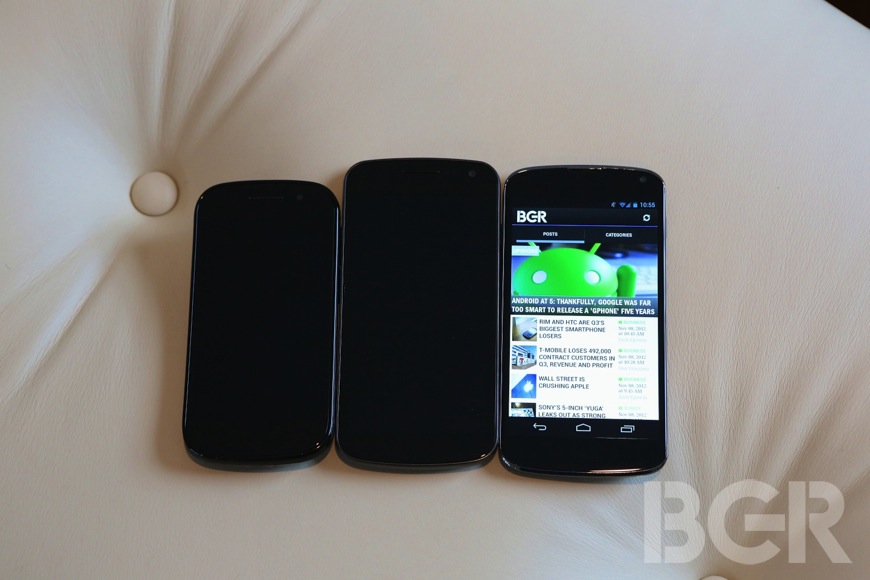Almost like clockwork, every year around this time, Google (GOOG) introduces a new version of the company’s flagship smartphone, the Nexus. This year, we have the Nexus 4 manufactured by LG (066570) instead of HTC (2498) or Samsung (005930). In addition to a new Nexus, the phone is usually accompanied by a new version of the Android OS, and with the Nexus 4 Google has introduced Android 4.2. These phones always try to set the bar for the Android ecosystem, but funnily enough, I have never found that to be the case in the past. Does the Google Nexus 4 change this?
Looking at the Nexus 4… you know what, picking up the Nexus 4, you can tell this is a quality device just like the LG Optimus G we recently reviewed. Not since HTC manufactured Nexus phones for Google has one felt this good. There’s a beautiful black slab of glass on the front with this soft touch black rubberized plastic mid-frame, and it is incredibly reminiscent of a BlackBerry to me — a BlackBerry Tour — but that’s a good thing in this case. It’s smooth but not slippery, and gives the phone a high-end feel. On the back is another piece of glass that covers a hypnotizing hologram effect which I really like.
And this is all while the phone is off. When you power the Nexus 4 on, you’re greeted with the best screen that I have ever seen on an Android phone. The resolution is fantastic — it’s not a garbage PenTile display and pixels aren’t visible — colors are vibrant, blacks are deep and the viewing angle is perfect too.
There isn’t a touch sensitivity issue per se, but Android is still lacking in that department compared to iOS. Scrolling isn’t perfectly accurate and touches aren’t always interpreted correctly, but I don’t think it’s related to this specific panel or phone, so that’s a good thing I guess?
The 4.7-inch display is a little large for me, and I honestly don’t understand how a single human uses a phone this size with one hand without dropping it. But that’s not anything new, so enjoy your 32oz sugary screens until Bloomberg bans them.
As a flagship phone, you’d expect Google and its partner to try to offer the best experience possible for every feature on the phone. Apparently Google doesn’t care about the camera experience or photos as it is all just a bag of sadness mixed with confusing circles and pop ups. Seriously, it is nearly impossible to figure out what you’re doing when you are taking a photo. I just don’t understand. It’s like Google wanted to make the interface so confusing you couldn’t figure out how to take a picture so you wouldn’t see how bad the quality is on this camera’s photos.
Besides the camera and the usual lack of polish in, well, everything, I really do like this phone. The battery is great, the phone is insanely fast, it’s reasonably thin, feels great to hold and use, and the screen is beautiful. But there’s one thing missing… LTE.
Not completely necessary a year ago, LTE is now standard in any mid- to high-end smartphone. Google’s excuse about interoperability with carriers doesn’t hold much weight in a day and age where Apple (AAPL) only sells two models of its smartphone in practically every part of the world besides China, and uh, the previous Nexus had LTE.
Here is the real problem… Google’s target market for the Nexus 4 is not average consumers, but technology obsessed individuals, and these are the users who are most likely to take issue with the new Nexus’ lack of LTE support.
One important factor in countering that, however, is that the Google Nexus 4 can be purchased for a mind-blowing $299 for the 8GB model… without a contract. Google’s best phone ever — in fact, the best Android phone ever created — can be bought for only $299 with no two-year agreement. It’s just insane. It’s said that Google is subsidizing the cost of each handset sold by up to $350 each, but that’s not your problem, now is it?
Aside from some very irritating shortcomings, the Nexus 4 is my favorite Android device in the world. It’s a great reference device to show other manufacturers how it’s done, and LG has done a beautiful job.








